
The Magic Artistry of Santa Fe
If you're a serious art buyer you know that New York is the number one market. You also know that Santa Fe is number two.
Santa Fe is known as "The City Different" and it far and away lives up to that description more than any other capitol in America. The second oldest city in America (next to St. Augustine, Florida), Santa Fe's centuries old Indian and Spanish heritages infuse its adobe walled streets and sweet smoky aroma of pinon fires with a magic that entrances, beguiles and beckons visitors throughout the year. And there is truly something about the high desert terrain, pine forested peaks, chromatic skies, and a filtering of light that has drawn artists, sculptors, potters, weavers, carvers, and writers to a place that seems to have a muse and creative divinity all its own.
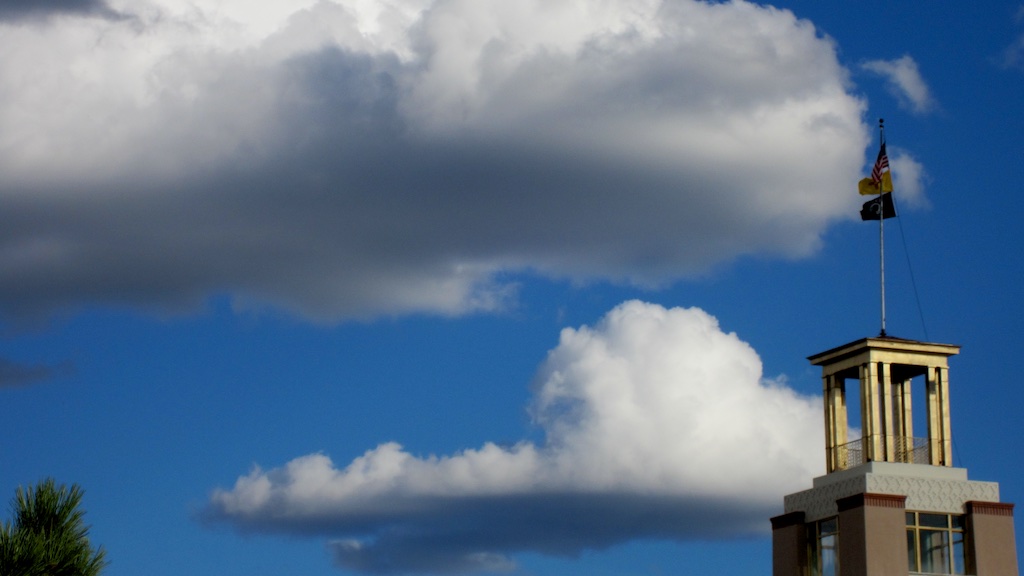 The ever changing New Mexican sky.
The ever changing New Mexican sky.
If you take a little time in Santa Fe and Northern New Mexico to pause and let nature push through the outer layers of your skin, deeper into your unexplained sense of environmental awareness, you can come to understand the unique and distinct pull this land has exerted on centuries of human souls who, whether they were in ancient Puebloan rooms or modern glass walled studios, were prodded and pushed by an unseen current of natural inspiration.
Somewhere along the lines, and quite a while after my first trip here with my parents, where I was still young enough to sleep with my mother's old teddy bear, Santa Fe became "Aspenized." My father sold dresses to a local store on the town square that, by the early 1980's had been sold and changed to sell expensive apparel that the locals neither needed nor could afford. But Santa Fe, the only city in America to live under the flags of foreign, territorial and state capitols, has gracefully weathered the upscale change.
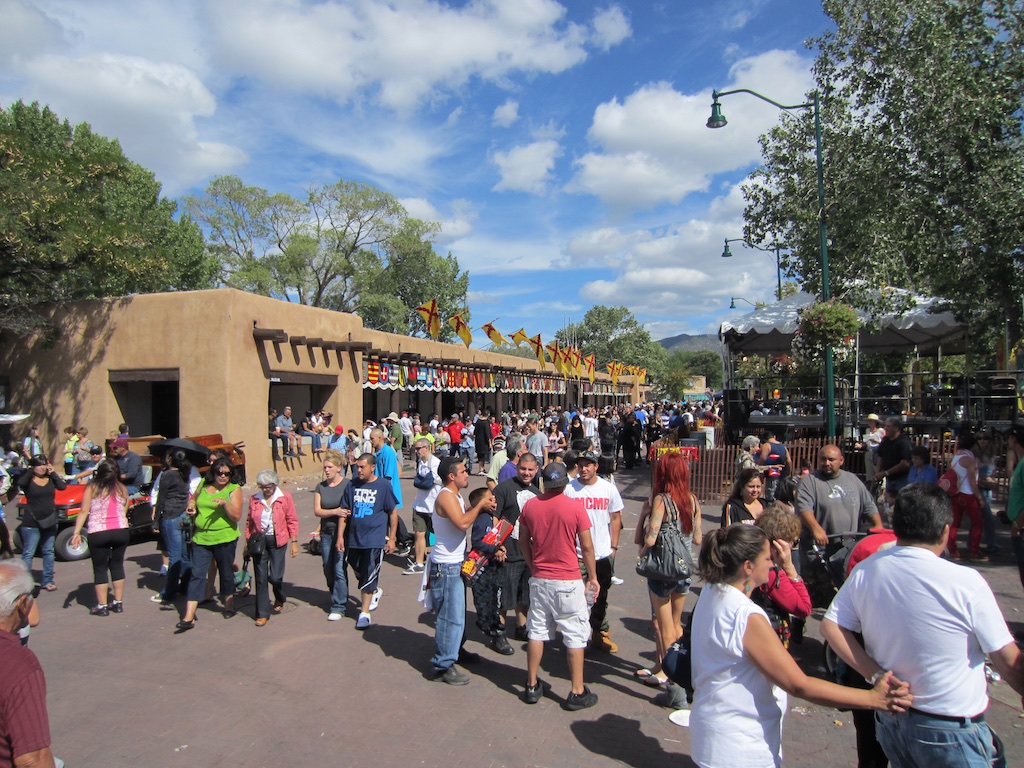 Even with high end boutique stores around the main plaza you can still buy native art displayed on sheets under the cover of the Palace of the Governors.
Even with high end boutique stores around the main plaza you can still buy native art displayed on sheets under the cover of the Palace of the Governors.
The magic of this city endures, only now more expensively. And over the last several decades Santa Fe has slowly transformed itself from a regional art market to a national one. There are many layers to the art market in America. As the trend of re-urbanization grows, so has the liveliness of art districts in many other cities we've visited.
High end resort areas such as Aspen and Laguna Beach are home to galleries that, more often than not, showcase regional art of mountains or the sea with prices calibrated to match their affluent visitor's net worth.
The spring and summer art festival scene that takes place in towns like Ann Arbor, Denver and Palm Springs with juried shows consistently offer highly original and creative art at more affordable prices which generally fall in the range of $1,000 to $3,000.
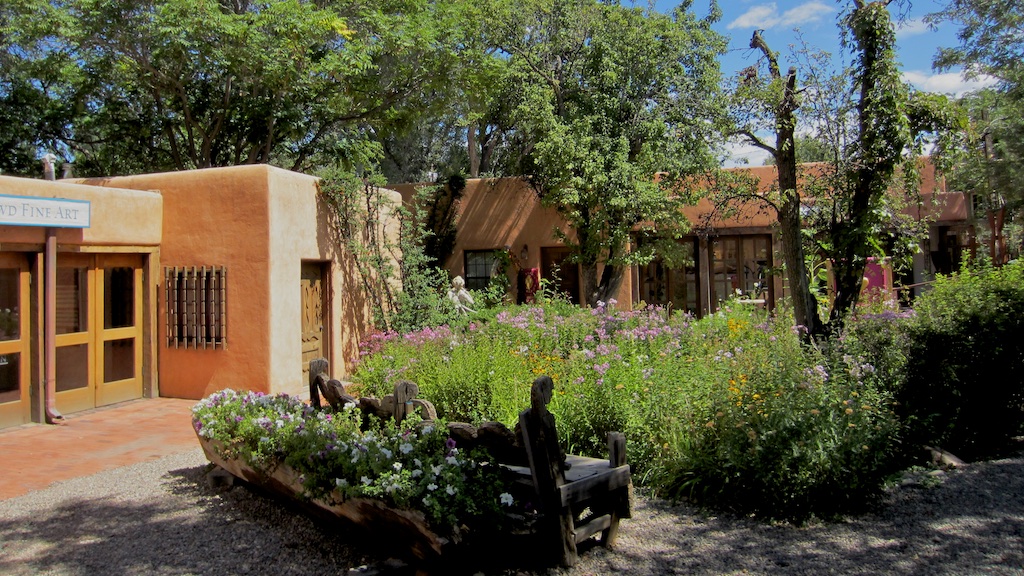 A gallery and gardens off of Canyon Road.
A gallery and gardens off of Canyon Road.
Santa Fe art takes the next step up with the sweet spot of pricing in the $3,000 to $25,000 range. But, there are also some even higher tier galleries offering the work of internationally known artists with prices that push into $1+ million territory.
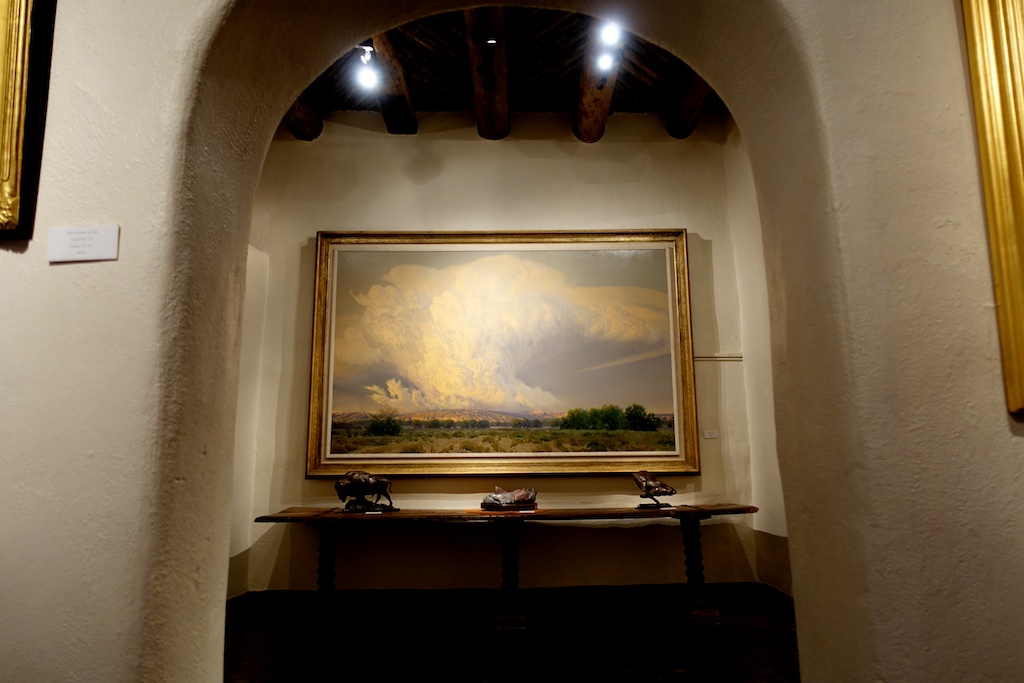 A painting hangs in the sprawling Nedra Matteucci Galleries where some classic canvases can cost more than $1 million dollars.
A painting hangs in the sprawling Nedra Matteucci Galleries where some classic canvases can cost more than $1 million dollars.
Galleries are scattered throughout Santa Fe's narrow downtown streets, the Railyard to the west and Canyon Road to the east. All are in walking distance if you don't mind covering a few miles either way.
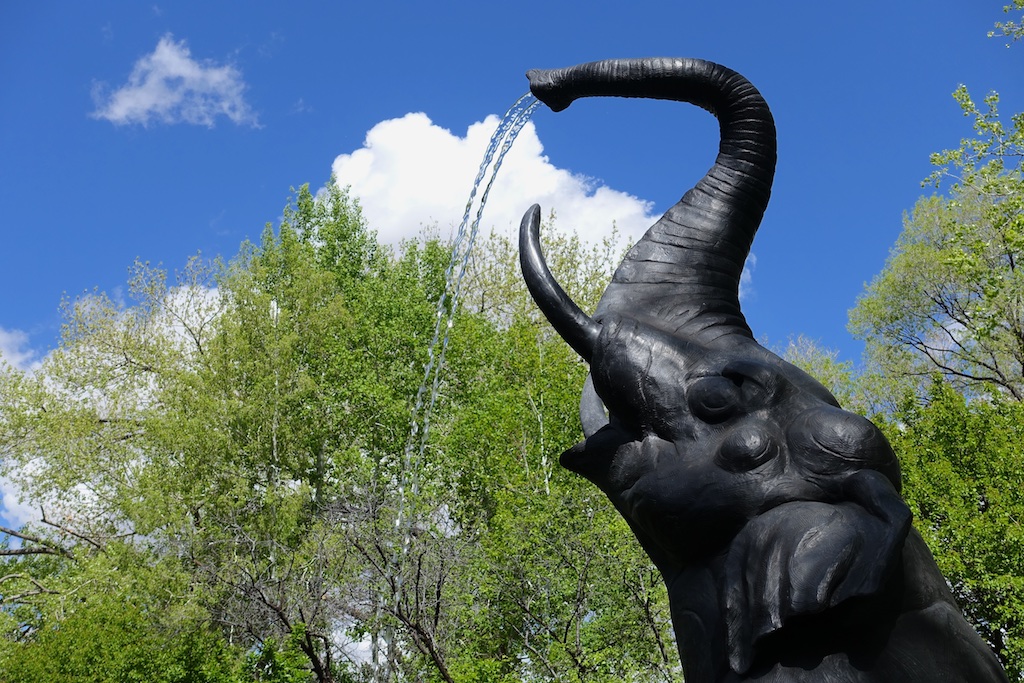 Whimsy and majesty at the delightful outdoor garden at Nedra Matteccuci Galleries.
Whimsy and majesty at the delightful outdoor garden at Nedra Matteccuci Galleries.
 Sculptor George Lundeen's "Nike Girl" in the Nedra Matteucci Galleries garden.
Sculptor George Lundeen's "Nike Girl" in the Nedra Matteucci Galleries garden.
Our favorite hunting ground has usually been to walk the mile or so up narrow Canyon Road. Galleries, which are mostly old converted homes, dot both sides of the road that sometimes gets so tight that it becomes a one way lane with only the narrowest of sidewalks on one side.
 Awaiting a meal of culinary artistry our table at Geronimo is ready.
Awaiting a meal of culinary artistry our table at Geronimo is ready.
A little past the mid-way point on Canyon Road is El Farol which is a lovely place to stop for lunch. Nearby are two of Santa Fe's most celebrated and well-known high end restaurants, Geronimo and the Compound. The ambience and cuisine of these restaurants has remained consistently good and you should expect a dinner bill of at least $100 per person. For its size, Santa Fe has a disproportionate number of good restaurants. The Shed in Sena Plaza has always been a favorite for reasonably priced southwestern/Mexican food. Other restaurants we've enjoyed are The Inn of the Anasazi, Santacafe, Coyote Cafe, La Boca and Bouche Bistro.
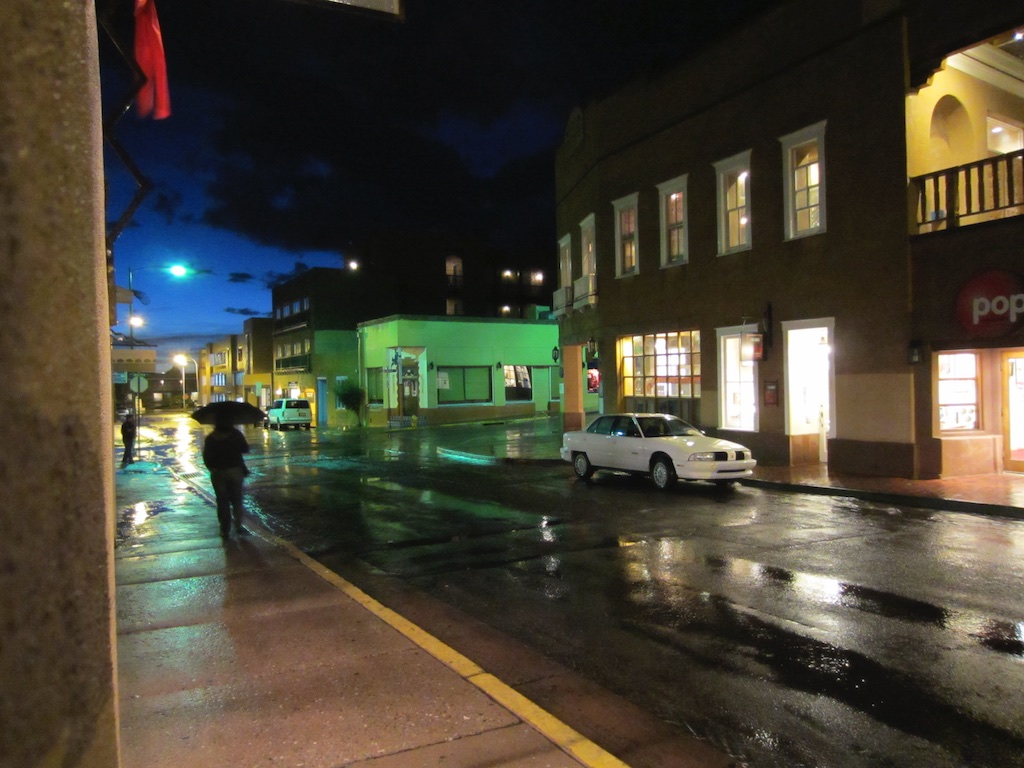 The Santa Fe streets are washed clean outside of the Coyote Cafe by a brief evening thunderstorm.
The Santa Fe streets are washed clean outside of the Coyote Cafe by a brief evening thunderstorm.
But, let me return from the artistry of food to the artistry. . .of. . .art. Even if you're not an aficionado or collector, a tour through the Canyon Road galleries can be a half-day well spent. We like starting at the lower end of Canyon Road and popping into all the galleries on the left side. Keep your eyes peeled as there are also some galleries off the main road on side streets and alleys. When we get to the Tea House at the upper part of Canyon Road, we then cross over and work our way back through the galleries that were on the right side as we walked up.
While some of the galleries feature jewelry and textiles, most focus on painting and sculpture. Yes, there's still plenty of western, southwestern and Indian art, but for the past decade or so, the majority of work is quite contemporary.
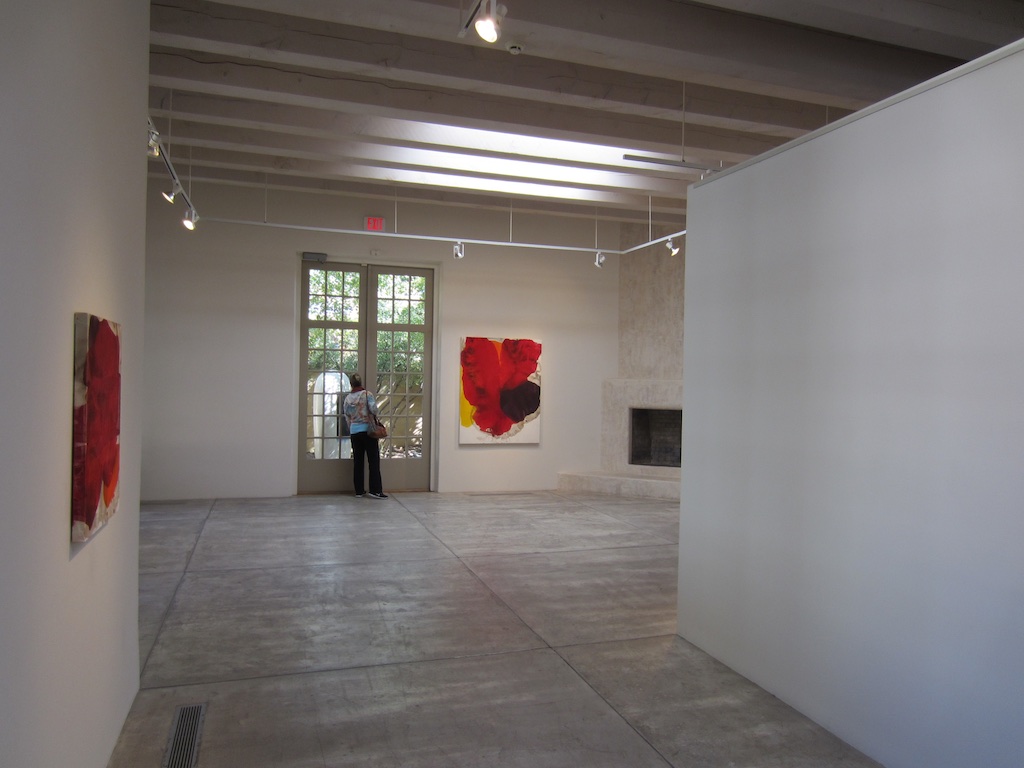 More that just southwestern art, Santa Fe offers fine contemporary choices in numerous galleries.
More that just southwestern art, Santa Fe offers fine contemporary choices in numerous galleries.
It's taken some years after the Great Recession for the art market in Santa Fe to regain a solid footing and after that economic forest fire it seems that the surviving galleries (and new one's that have opened) display more tightly cohesive and curated collections.
I've often likened buying art to drafting NFL football players. Sometimes you draft for position and sometimes you pick the best athlete. Some of our trips we've had a budget in mind, akin to planning how much you're willing to lose in Vegas. In other trips there was nothing that sparked our interest. We buy for pleasure, not collectable value, and generally our tastes lean towards more modern art that often sits between representational and abstract. We're keenly aware of our limited collection as we carry a visual memory and iPhone photos of our loft layout. While many travelers acquire and display an eclectic collection of artifacts they've purchased every item tells a story or recalls a memory our interest and discipline remain pretty focused on the singular appreciation of a piece and how it integrates into our living space.
There are those trips through the galleries where we can be very objective oriented. Fill a spot on a wall, add a visual counterweight to something we already have, or increase a collection. Generally we think about doing a leisurely paced survey of the galleries with a plan to return if we're really intrigued with something. But that rule went out the window on one trip where the first gallery we stepped into we saw a collection of selenite crystals (gypsum quarried in Mexico) sitting on an LED illuminated pedestal that changed color. We had just ordered a new wall unit for our living room and recognized that this crystal would add a perfect touch of dynamic color.
By and large gallery owners and sales associates are very low pressure sales people. The best of them, when gently coaxed, knowledgeably tell you more about the artist and his or her vision and viewpoint. One the greatest satisfactions in art acquisition is knowing about the artist and, on many occasions, specifically art festivals, actually meeting them.
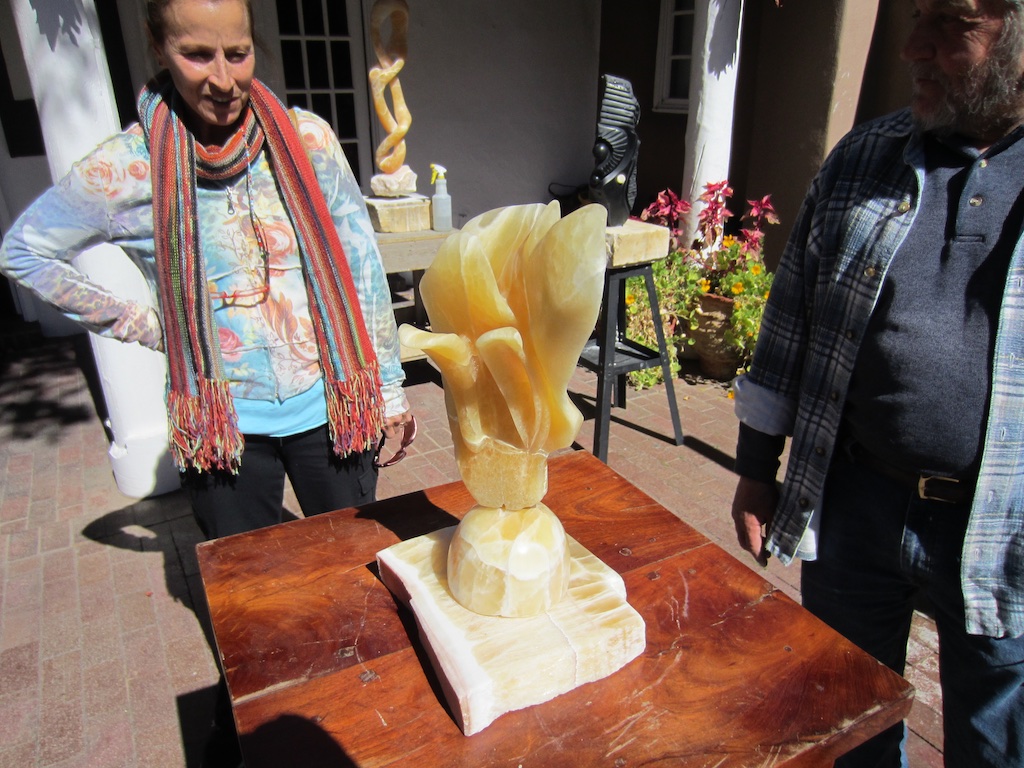 Terry admires an alabaster sculpture as the artist explains his delicate carving technique.
Terry admires an alabaster sculpture as the artist explains his delicate carving technique.
I have another rule about art. Just like new shoes must be comfortable the moment you try them on, an art piece needs to immediately captivate you. However, it's really good to "test your love" by making note of what you liked and keep on looking. It's amazing how 500 yards and four galleries later can cause a purchase fever to break. On the other side of the coin I had a Santa Fe experience a few years ago at one downtown gallery. There I stood, mesmerized by a large canvas that radiated the autumnal light of a high country stream. I love western landscapes (especially the 19th century work of Russell, Remington and Moran), but I'd never had considered owning that style. Well, not until I saw this painting. Standing there I could smell the sweet pre-decay of the cottonwood leaves, feel the slight pressure of water against my shins through my fishing boots, and hear the muted rush of water wrapping around the rocks just ahead. Yes, this experience could forever be mine in our living room for the modest sum of $8,000 dollars. To this day I cannot recall what competing economic interest slammed the door of the checkbook, but I still remember driving back to our home in the Vail Valley thinking about that painting.
Three years later, with more economic resolve, I returned to the gallery. Of course that painting was gone, but I was hoping the artist would have another. Well that plan unfortunately died, along with the artist. The gallery owner told me that he had passed away shortly after I had first seen the painting. And then he said something that has since stayed with me, "In art, the only regrets I've ever had are for the ones I didn't buy."
******************
The two campgrounds we like to stay at are Trailer Ranch RV Resort and Santa Fe Skies.Trailer Ranch is a cute and small park that's less than a ten minute drive or easy bike ride to the center of town. It's an adult only (21+) park and, because of proximity, our first choice. However, space availability can be an issue and it's pretty tight for big rigs.
On our most recent stay with two of our big rig friends we chose Santa Fe Skies which is very easy to get to off of I-25 and sits up on a ridge with great views all around of the dynamic New Mexican skies. It's about a 20-25 minute drive into the heart of downtown Santa Fe. From the park it's less than a 10 minute walk to the Rail Runner station which offers train service into town. However, this is more a commuter rail line with limited morning and afternoon/evening service.
RVers be warned! Downtown Santa Fe is a five hundred year old town with narrow streets. It's best to look for parking opportunities just to the southwest of the city center near the rail station.
Comments
Comments on this post are moderated, so they will not appear instantly. All relevant questions and helpful notes are welcome! If you have a service inquiry or question related to your RV, please reach out to the customer care team directly using the phone numbers or contact form on this page .